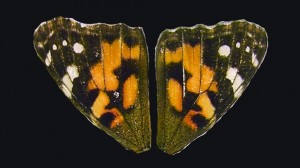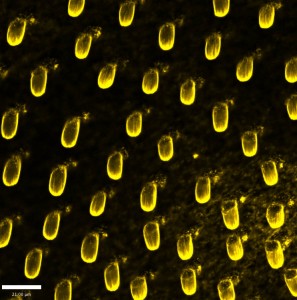Project:
The interactions of an organism with its ecological community are directly influenced by
its appearance. An organism’s coloration can attract mates, warn others of a poisonous/venomous defense, serve as camouflage, or mimic other species. The insect order Lepidoptera (moths and butterflies) has long been recognized as an ideal group for investigating these interactions. With an estimated 140,000 species covering every continent except Antarctica, the Lepidopteran wing patterns represent one of the most thorough explorations of phenotypic space available to science. These patterns are produced by the mosaic juxtaposition of thousands of individually colored, derived hair cells known as scales.
 Pigmentation is the best-understood means of coloration, but butterflies have also evolved pigmentless color that relies upon diffraction gradients and thin-layer refraction. The structures needed to produce this kind of color are on the order of 100nm in size and are remarkably well reproduced from scale-to-scale and individual-to-individual despite having quite elaborate shapes.
Pigmentation is the best-understood means of coloration, but butterflies have also evolved pigmentless color that relies upon diffraction gradients and thin-layer refraction. The structures needed to produce this kind of color are on the order of 100nm in size and are remarkably well reproduced from scale-to-scale and individual-to-individual despite having quite elaborate shapes.
Biophysical studies on butterfly structural coloration have produced a wealth of data describing the nanostructures and physics involved in their coloration. However, little is known about how butterflies actually build these nanostructures during development.
 We are interested in understanding how butterflies erect these nanostructures during pupal development and how manipulating the developmental process can modulate coloration across closely related species. We are currently investigating these factors through a combination of microscopy, cell biology, and bioinformatics across a plethora of genera and species.
We are interested in understanding how butterflies erect these nanostructures during pupal development and how manipulating the developmental process can modulate coloration across closely related species. We are currently investigating these factors through a combination of microscopy, cell biology, and bioinformatics across a plethora of genera and species.
Personal:

I matriculated to Berkeley in 2011 after completing degrees in Evolutionary andCellular/Molecular biology at the University of Texas at Austin. My research interests include understanding how changes in developmental programs influence morphology, the diversity of form found across the insect orders, and the synthesis of biogeography with genomic evolution.
Outside of the lab I enjoy following industrial design and architecture, ridiculously colored footwear, data visualization, and dreaming about motorcycles.


